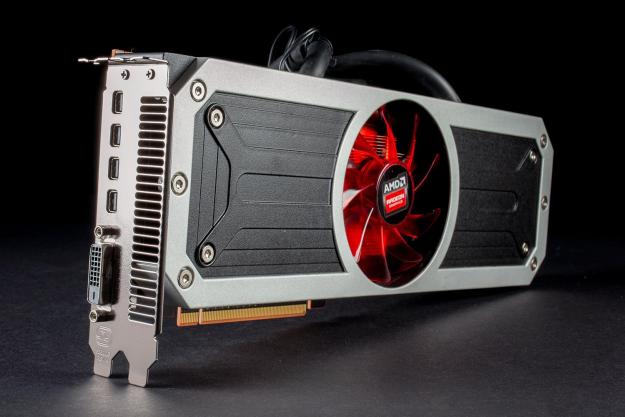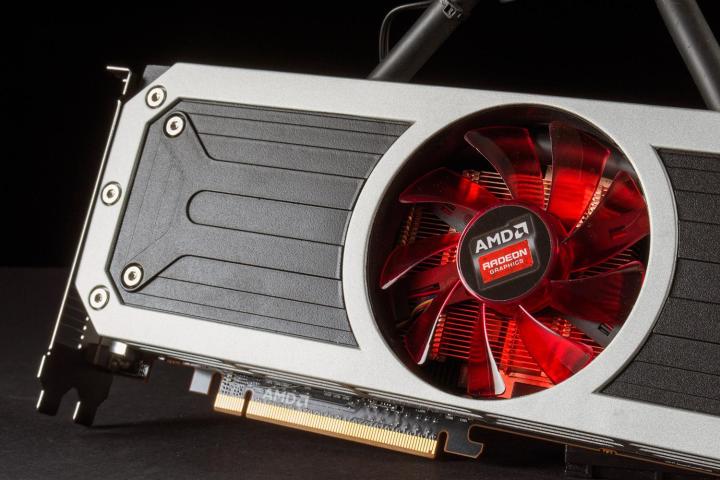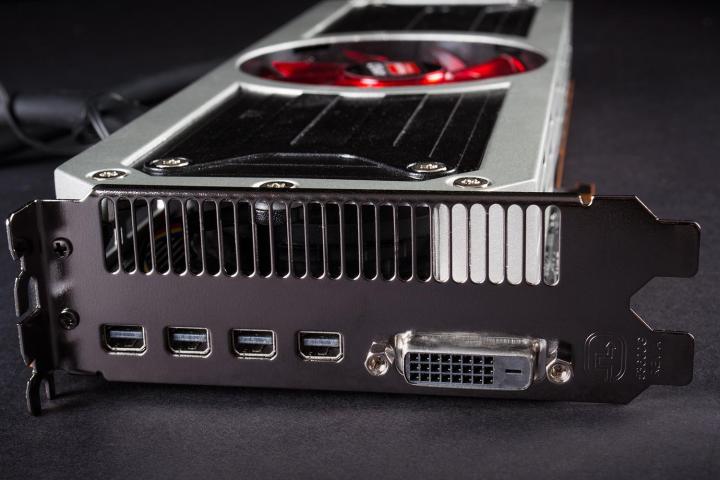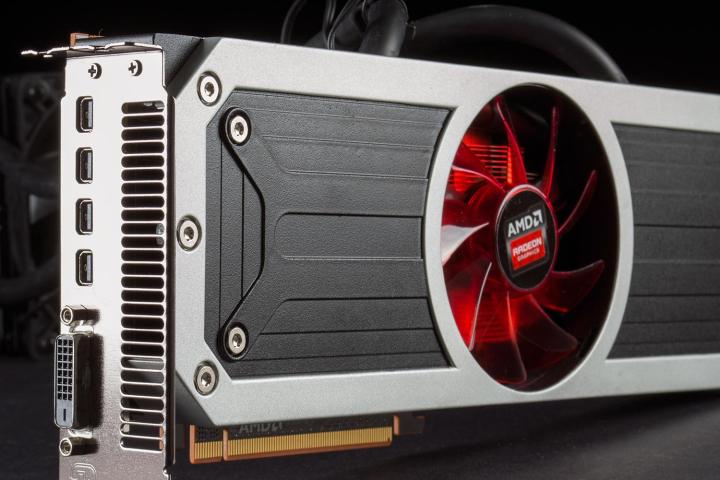
“The massive Radeon 295X2 can easily handle modern games, even at 4K, but its high price makes it suitable for only the most die-hard gamers.”
- Fastest video card available today
- Gobs of memory bandwidth
- Impressive specifications and design
- Water-cooled
- Needs two 8-pin PCIe power connectors
- Large, requires 120mm fan mount for water cooler
- Drivers aren’t mature
There is an eternal conflict that’s been waged for over a decade. Every year the fight continues, each side deals blows to the other, each striving to gain even the slightest foothold. I am talking, of course, about the war between AMD and Nvidia.
The title of “world’s most powerful video card” is the crown that this war is fought over. Though few people actually buy the most powerful card on the market, its existence has a halo effect, and is used as ammo in forum battles about which company is the best. The crown has traded places countless times over the last decade, as each side counters the other.
Since late 2013, however, the war has been tied. Nvidia’s Titan Black and AMD’s Radeon R9 290X offer very similar performance, making it hard for either to definitively claim the title of “most powerful.” Now, AMD has a piece of hardware that it hopes will sway the conflict in its favor; the $1,499 Radeon R9 295X2.
The 295X2 takes two of the company’s fastest graphics cores and slaps them onto a single circuit board. This is a tried-and-true method of creating a new “world’s fastest” video card that has been used several times in the past, but it’s a tactic that has often resulted in performance oddities and graphical glitches. Has AMD managed to avoid these pitfalls and deliver the best video card ever?
Hands on video
Two in one
AMD shipped the Radeon 295X2 in a large briefcase full of foam padding. Absurd as that may seem, it was probably a wise idea. This card is massive, measuring 13 inches long, and it’s water-cooled from the factory. That means a radiator, a fan, and the tubes routing fluid to and from the card were already attached when we received the hardware.
Though impressive, water cooling causes some practical problems. Owners will have to find room not only for the card’s length and height (as this is, of course, a double-wide card that will obstruct any PCI slot below the slot into which it’s installed), but also for the radiator and fan, which requires a 120mm fan mount. Our test rig didn’t happen to have one free, so we had to make room by detaching an exhaust fan.
The cooler is required to handle the twin GPUs, which offer a combined 5,632 stream processors cranking out 11.5 teraflops of raw compute power. In other words, the Radeon 295X2 is over six times more powerful than a PlayStation 4 (which quotes 1.84 Tflops), and twice as powerful as the Nvidia GTX Titan Black (which quotes 5.1 Tflops) – on paper, at least.
Memory performance looks equally impressive. The Radeon 295X2’s GPUs talk to the motherboard over a 512-bit memory interface connected to 8GB of GDDR5 RAM. This translates to over 640 GBps of memory bandwidth, which is almost twice the 336 GB/sec delivered by the GTX Titan Black. The raw bandwidth provided by the 295X2 is astounding, and should be more than enough to handle 4k.
The 295X2 will simply demolish any other single card on the market today.
Though the 295X2 is a single card, its use of dual GPUs necessitates an internal CrossFireX connection. This means that the card runs in CrossFire mode by default, even though it occupies only a single PCIe slot. This creates some potential problems because, as anyone who has used a dual-GPU graphics card knows, not all games work well with CrossFire (or Nvidia’s SLI). Driver support has come a long way over the years, but there are still situations where you may not be able to take full advantage of the power offered by both GPUs. This is usually the case with very new or very old games that don’t have CrossFire or SLI driver support.
Price and positioning
The AMD Radeon R9 295X2 is expected to hit retailers later this month at a price of $1,499. That’s a lot, but not unexpected. After all, the latest high-end cards from Nvidia, like the Titan and Titan Black, have generally sold for around $1,000 – but they also have a single GPU.
The Titan is not the most obvious performance competitor, however, as it is sold not just as a gaming graphics card, but also as a workstation card capable of significant double-precision performance. The real rival to the 295X2 is not one card, but two; the Nvidia GeForce GTX 780 Ti configured in two-way SLI. These cards sell for around $700 each, which puts the total cost at $1,400.
A pair of 780 Ti cards line up with the Radeon 295X2’s on-paper performance. Each provides 5.04 Tflops of compute, which adds up to about 1 Tflop less than the Radeon. The cards use a narrower 384-bit memory interface as well, and make do with 3GB of RAM on each card, for a total of 6GB; 2GB less than what the 295X2 packs. We’re interested to see if that has a noticeable negative impact on 4k performance.
The Radeon R9 295X2 looks like it’s tied with the GTX 780 Ti SLI setup, on paper at least. AMD’s hardware should be more powerful, but it also costs $100 more, and it’s impossible to know without testing if its additional memory and bandwidth grant it a significant advantage. With that said, let’s get to the benchmarks.
Our test system
Falcon Northwest’s Talon serves as our test system. The tower boasts a Core i7-4770K processor overclocked to 4.5 GHz, 16GB of RAM and two 240GB SSDs running in RAID 0. These impressive specifications make it unlikely that any portion of the system aside from the video card will be a bottleneck, and will provides us with accurate benchmark results.
Synthetic performance
We began our examination of the Radeon R9 295X2 with synthetic performance benchmarks. These are not real games, but instead test loops meant to simulate them. Their advantage is precision, as the settings and conditions of each loop never varies. This makes them great for judging relative performance.
3DMark
Our testing begins with 3DMark, an extremely popular cross-platform benchmark. We pay attention to two scores, one from the Cloud Gate test loop, which represents a moderately demanding title, and Fire Strike, which emulates cutting-edge 3D graphics. We run this benchmark at default settings.

Unigine Valley
Next up is Valley, a benchmark from Unigine which features beautiful sweeping vistas and towering forests. This test loop is a good stand-in for games that feature sprawling outdoor areas.


Unigine Heaven
The Heaven benchmark focuses on high-polygon buildings and objects rather than scenery, and this generally means that it runs slower than Valley, but it also has higher peaks and lower troughs.


Are you starting to see a trend here? So are we! Once again, the Radeon wins at Medium detail, but loses at Ultra. This time, the difference is more substantial than it was in Valley.
Real-world game performance
Normally, we test games at 2560×1440 with FRAPS but, because of this card’s power, we felt it was necessary to also test at both 1440p and 4k resolution.
Total War: Rome 2
We lead off with Total War: Rome 2, Creative Assembly’s controversial strategy game. Though it was released with more than its fair share of bugs, this is one of the most visually enticing strategy titles ever crafted, and it’s very demanding at high detail settings. Let’s see how our dual-GPU wonders fared.

At Medium detail we can see that, no matter the resolution, the average framerate halts at around 90 FPS. There’s obviously a bottleneck restricting performance, though it’s certainly not the video cards. Realistically, it hardly matters, as 90 FPS is plenty quick.

We see a better comparison at Extreme detail, where the Nvidia GTX 780 Ti SLI configuration earns a small, but consistent lead. The extra frames aren’t noticeable in real-world gaming, but a win is a win.
Battlefield 4
The latest first-person shooter from DICE provides cutting-edge visuals and huge battlefields that can tax even the newest hardware. While we have no doubt that the Radeon R9 295X2 can handle the game at 2560×1440, we wondered how it would tackle 4k. Let’s take a look.

At 2560×1440, the Radeon has an obvious advantage. At Extreme detail, it beats the Nvidia cards by over 10 frames per second. And please note, we are not using AMD Mantle in this benchmark.

At 4k, however, the story changes. Nvidia takes a commanding lead at Medium detail, and a very minor lead at Extreme. Again, it’s only a lead of a few frames per second, but a win is a win.
Still, the Radeon R9 295X2 is indeed capable of playing Battlefield 4 at Extreme detail. The card’s average framerate of 52 FPS is more than enough for enjoyable gameplay.
Borderlands 2
Borderlands 2 is a couple of years old, but it’s a popular title that can still prove demanding when played at high resolution on a mid-range video card. The game also uses Unreal Engine 3, which is incredibly common. Let’s see how our pair of wonder twins handled Borderlands 2.

As with other benchmarks, performance between the Radeon and Nvidia setups proved to be incredibly similar. In fact, we received the exact same average framerate when we tested the game at 4k resolution with all details turned on and/or set to Maximum.

The only oddity of note here is the 295X2’s performance at 2560×1440 with detail set to Medium. At that setting, we received an average of 153 FPS, which is 22 FPS less than what the pair of GTX 780 Tis managed. The 295X2 also produced the exact same average at Medium detail when the resolution was kicked up to 4k. We’re not sure what caused this, but we confirmed it by re-testing the game multiple times, re-installing the game, and re-installing the driver, none of which changed the result.
League of Legends
Riot Games’ free-to-play hit is the least demanding game in our test. Still, it’s good to see how less demanding games play on high-end hardware. These titles aren’t always targeted for driver optimizations, so results can vary, and bugs can emerge.

The Nvidia cards clearly win here, though it hardly matters. Both dual-GPU arrangements can blast through the game without breaking a sweat. With V-Sync on, the cards use so little of their maximum grunt that fan speed rarely deviates from idle.

We did run into a hitch while playing using the Radeon card, however. The game has specific graphical effects that appear around the borders of the display to indicate that heavy damage was inflicted. When these appeared, the screen would flicker, as black horizontal bars strobed up and down the screen. This problem always stopped when the effect was over, but it was very distracting.
Crysis 3
Crysis 3, the latest game in the Crysis franchise, is also one of the most demanding games on the market. Even Battlefield 4 is a cinch to run compared to this monster. How do these cards handle it at 2560×1440 and 4k?

At 1440p, the pair of Nvidia cards manages a better experience, providing an average of 6 extra FPS at Very High, and over 20 more at Medium. We felt this in-game as well; it seemed that the GTX 780 Tis created smoother gameplay, and we noticed less screen tearing (with V-Sync off).

At 4k, however, the SLI configuration runs out of steam – or, to be more accurate, memory. While it holds its own at Medium detail, upping the settings to Very High brings the framerate to a standstill. This is an obvious sign that the GTX 780 Ti simply lacks the memory bandwidth required. The Radeon doesn’t really provide a playable experience either, but it’s much closer. Turn down a couple of features in the “Advanced Graphics” section, and you’ll get around 30 FPS.
Need more power!
Our wattmeter caught our test system drawing 103 watts at idle. That’s actually rather impressive, as it’s 31 watts more than what our system required when equipped with AMD’s significantly less powerful Radeon R7 250X card. Idle power efficiency has greatly improved over the last half-decade.
At full load, however, consumption increased to 617 watts. That’s certainly a lot, and if this were a desktop PC review, we’d have to remark that our test rig is the third most power-hungry gaming PC we’ve ever seen. High power draw is to be expected, however, and physics must be obeyed. Extreme performance demands extreme power draw.

While the 295X2 is efficient, the pair of Nvidia 780 Ti cards drew even less power. They consumed only 76 watts at idle. That’s amazing because our test rig needed 72 watts to power a single Nvidia GTX 650. The green team needed less power at load too, as we measured 582 watts of power draw while gaming.
Conclusion
There’s no doubt that the Radeon R9 295X2 is the fastest single video card on the market right now. While Nvidia has announced a dual-GPU card called the GTX Titan Z, it’s not yet available, and it’s targeting a much higher $3,000 price point. The 295X2 will simply demolish any other single card on the market today, including the GTX Titan Black and the GTX 780 Ti. This advantage translates to the ability to handle demanding games at 4k resolution and respectable detail levels, something single-GPU competitors can’t offer.
Does that mean you should buy the R9 295X2? That depends. While impressive, our tests show that a pair of GTX 780 Tis can trade blows with AMD’s latest at 2560x1440p, and they do so without a bulky, awkward water cooler. Nvidia’s hardware consumes less power, and the drivers are more mature because the product has been on the market since last year. The Radeon R9 295X2 also costs $100 more than a pair of GTX 780 Ti cards.
4k performance is the Radeon’s advantage. While it doesn’t always win the framerate battle, it completely destroyed the 780 GTX Ti SLI setup in Crysis 3. That’s an important victory, because the SLI configuration’s slide-show result at 4k and Very High detail shows that video memory could be a limiting factor in future games. The twin 780 GTX Ti cards are competitive at 4k right now, but will they be tomorrow?
The 295X2 only makes sense for gamers with deep pockets who want to game at 4k before anyone else. If that sounds like you, this is the only single video card that can satisfy your needs.
Highs
- Fastest video card available today
- Gobs of memory bandwidth
- Impressive specifications and design
- Water-cooled
Lows
- Needs two 8-pin PCIe power connectors
- Large, requires 120mm fan mount for water cooler
- Drivers aren’t mature









